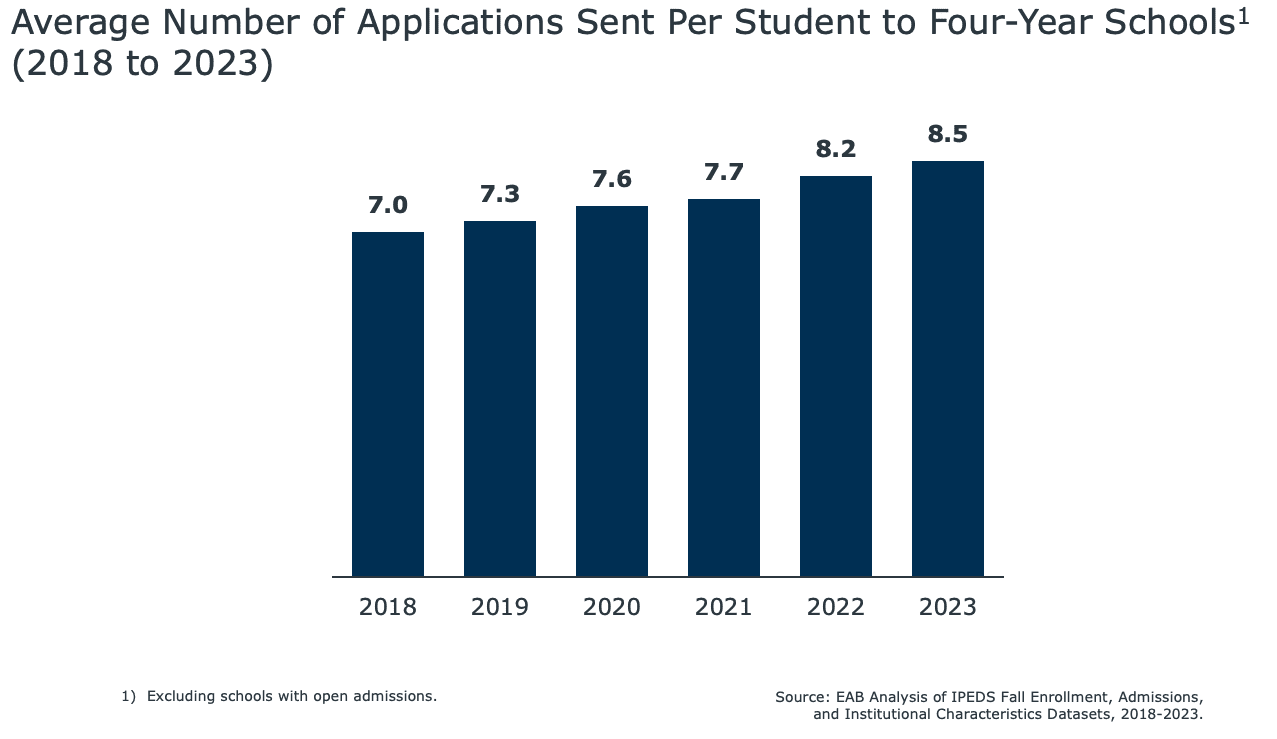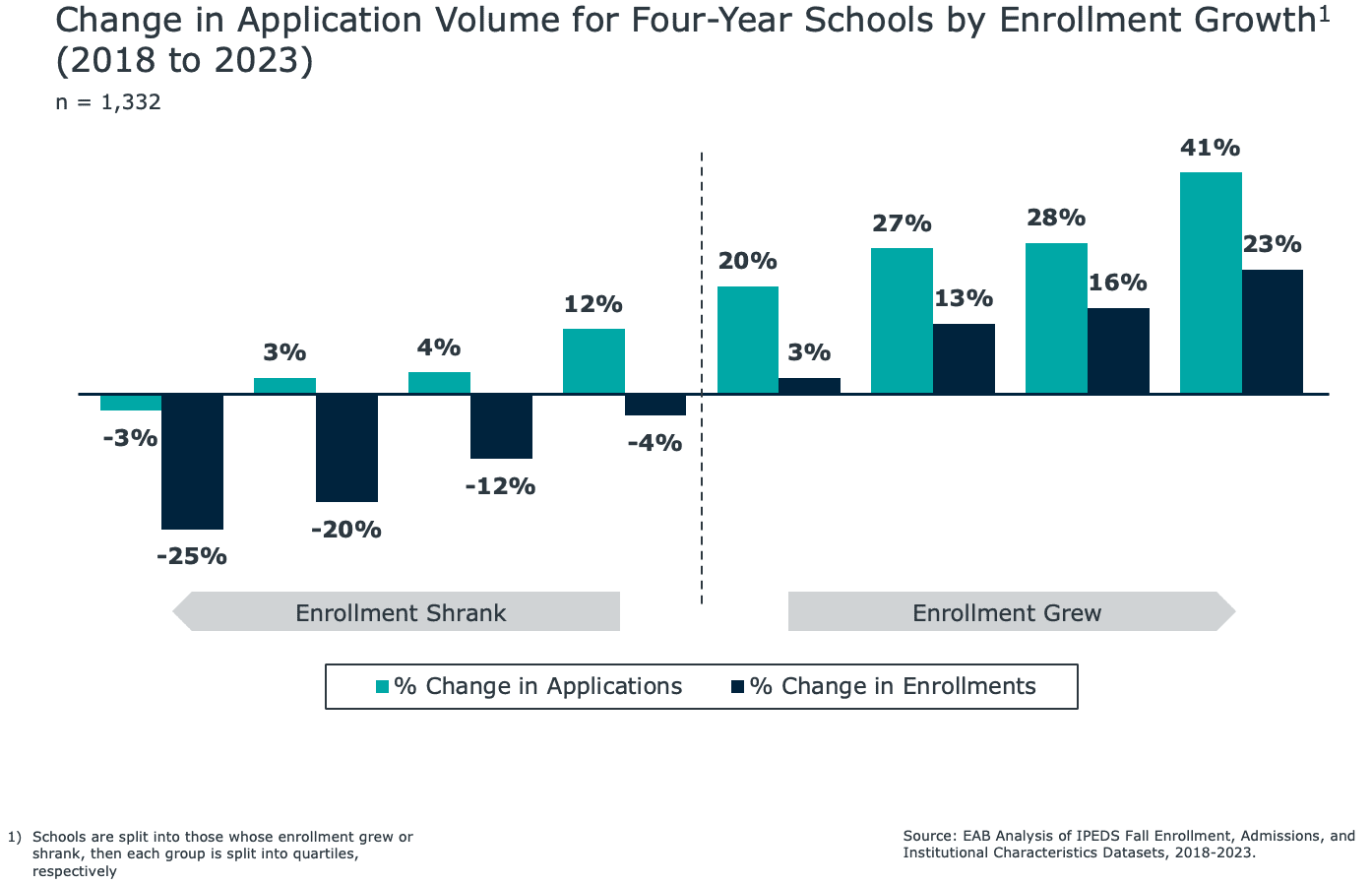Students are applying to more colleges than ever before: What this means for your enrollment strategy
Enrollment leaders often debate whether success comes from focusing on application volume or just high-propensity prospects. Both matter, but our latest research shows that high application growth has become the baseline for maintaining enrollment—not just for expansion. Schools that fail to keep pace with the market’s application growth are the ones losing students.
We’ll unpack why this is the case in this blog post. First, we’ll look at the basis for this market-wide shift—the steady rise in applications per student. Then, we’ll turn to the data showing how much “outsized” application growth is now required for institutions simply to keep enrollment steady, let alone grow it.
The basis for application list growth
The average student is sending more applications than ever before. In 2018, students submitted about seven applications each to competitive four-year schools. By 2023, that number had climbed to 8.5, which is a 21% increase in just five years. Multiply that change across millions of prospective students and it means that admissions offices are dealing with unprecedented numbers of interested prospects.

-
+21% growth in applications per student over five years.
Many barriers have come down over this period (e.g., test-optionality, simplified applications), which helps explain this trend. One particular driver of this is the Common App, which now accounts for roughly half of all U.S. applications and is rising quickly. As more students apply through a single platform, adding an extra school to their list is easier than ever, consequently raising the bar for institutions to keep pace.
-
Explore other trends shaping enrollment in this on-demand webinar
If you don’t have outsized application growth, you’re losing enrollment
Our analysis of application and enrollment data for all competitive 4-year schools shows that, from 2018 to 2023, institutions typically needed 20% application growth over five years just to achieve minimal enrollment gains. Schools that grew less than that saw enrollment decline, even if they still added applications.

Put plainly: moderate application growth isn’t enough anymore. You need outsized application growth to offset the reality that students are spreading their bets across more colleges. And this isn’t limited to one type of school. We’ve seen the same pattern play out across regions, segments, and levels of selectivity. Large public schools, small private ones, and everything in between now face the same reality: the bar for application growth is higher than it used to be.
Why not just focus on high-intent students?
A common criticism of the “volume imperative” is that chasing applications simply creates more work, while lower-intent students rarely convert. In practice, two realities help explain the trends noted above and argue strongly for courting more applications:
- Marginal applications still matter. As the average prospect adds one or two extra schools to their list, your odds of being “the one” go down (because even those extra applications sometimes turn into enrollments, albeit at lower rates). But that same trend also creates opportunity: the more lists you appear on, the more of those small wins you can capture. And at scale, those incremental enrollments add up to a meaningful share of your class.
- You can’t convert students who never applied. With the right outreach, engagement, and financial aid strategy, many of these lower-intent prospects can be cultivated into higher-intent enrollees. Gaining the application is what gives you the opportunity to make that case.
That’s why the imperative isn’t volume versus likely admits, it’s volume and likely admits. You need to expand the funnel broadly at the top while sharpening outreach at each stage to maximize intent. Tools that help manage higher applicant volume alongside platforms that deliver higher-intent leads can make this balance sustainable.
The Hidden Impact of Your Student Recruitment and Influence Channels
The strategic takeaway
Students applying to more schools ratchets up the competition. A 10% bump in applications over five years may feel like progress, but in today’s environment it is likely to signal enrollment decline. That means outsized application growth isn’t about chasing volume for its own sake, it’s about maintaining market share in a world where students keep adding more applications.
The schools that succeed are those growing applications faster than the market, while also nurturing and converting high-intent prospects. Each additional application isn’t waste—it’s a chance at an enrollment you can’t afford to leave to competitors.
To see where you stand in today’s market, here’s a quick test: compare your applications from five years ago today. If you haven’t grown them by at least 20%, you’re already losing share. Focusing solely on high-intent prospects and yield can only take you so far in this environment.

More Blogs

The real demographic crisis isn't national—it's regional

How AI-powered ad filters are disrupting enrollment marketing campaigns
